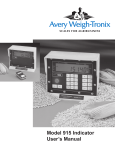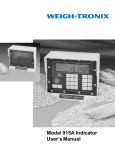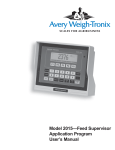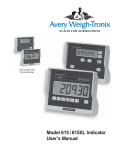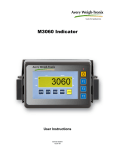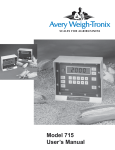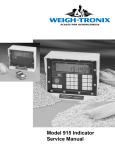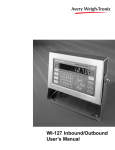Download Model 915 - Scale Tec
Transcript
Model 915 Indicator User Instructions 29591-0012 Issue AG March 2013 © Avery Weigh-Tronix, LLC 2013 All rights reserved. No part of this publication may be reproduced, stored in an electronic retrieval system, or transmitted in any form or by any means, electronic, mechanical, photocopying, recording or otherwise without the prior written consent of the copyright owner, or as permitted by law or under license. Full acknowledgment of the source must be given. Avery Weigh-Tronix is a registered trade mark of the Avery Weigh-Tronix, LLC. This publication was correct at the time of going to print however, Avery Weigh-Tronix, LLC reserves the right to alter without notice the specification, design, price or conditions of supply of any product or service at any time. All third party brands and product names used within this document are trademarks or registered trademarks of their respective holders. 915_u_en_29591_0012.book Table of Contents page Chapter 1 General information and warnings ......................................................................................... 5 About this manual .............................................................................................................. 5 Text conventions ......................................................................................................... 5 Special messages ....................................................................................................... 5 Customer Service Information ........................................................................................... 5 Chapter 2 Specifications ........................................................................................................................... 6 Chapter 3 Options ...................................................................................................................................... 7 Chapter 4 Introduction .............................................................................................................................. 8 Front Panel ........................................................................................................................ 8 Keys ............................................................................................................................ 8 Chapter 5 Cable Connections and Power Requirements .................................................................... 10 Chapter 6 Indicator Operation ................................................................................................................ 11 Gross Weighing ............................................................................................................... 11 Net Weighing ................................................................................................................... 11 Working with Tares .................................................................................................... 11 Net Weighing Operation ............................................................................................ 13 ID Number Entry .............................................................................................................. 14 View Current ID ......................................................................................................... 14 Clear Current ID ........................................................................................................ 14 Printing a GTN Report ..................................................................................................... 15 Storing Data In The 0-99 Memory Registers ................................................................... 16 Storing Numeric Data in a Specific Memory Cannel ................................................. 16 Storing Numeric Data in the Current Memory Channel ............................................. 16 Storing a Gross or Net Value in a Specific Memory Channel .................................... 17 Adding or Subtracting an Entered Weight Value To/From a Specific Memory Channel 17 Storing a Gross or Net Value in the Current Memory Channel ................................. 18 Adding or Subtracting an Entered Weight Value To/From the Current Memory Channel 18 Viewing Memory Channel Accumulators ................................................................... 18 Viewing Total Accumulator of All Memory Channels ................................................. 19 Clearing All the Accumulator Channels ..................................................................... 19 Printing Data Stored in Memory Channels ................................................................ 19 AUTO Function ................................................................................................................ 20 Setting up the Acc-Sec parameter ............................................................................ 20 “IN” Operation with Tare ............................................................................................ 21 Performing an Auto Accumulate Weighment (“IN/OUT” Operation) ................................ 22 Viewing and Setting the Time .......................................................................................... 24 Viewing and Setting the Date ........................................................................................... 24 Checking Battery Voltage ................................................................................................ 24 Diagnostic Tests .............................................................................................................. 25 Chapter 7 Troubleshooting ..................................................................................................................... 27 Power-On Failure ............................................................................................................. 27 Stalled Display Following Power-On ................................................................................ 28 Indicator Lock-Up ............................................................................................................. 29 Inaccurate Weight Readings ............................................................................................ 29 Alarm Light Function ........................................................................................................ 30 Measuring Supply Battery Voltage ................................................................................... 30 Model 915 Indicator User Manual 3 Service Repairs ................................................................................................................ 30 Display Messages ............................................................................................................ 31 Chapter 8 Miscellaneous Information .................................................................................................... 32 Mounting the Model 915 .................................................................................................. 32 RD 912 Remote Display .................................................................................................. 33 Optional Radio Remote Transmitters (XM710-L and XM910) and Receiver ................... 33 Chapter 9 User’s Menu ............................................................................................................................ 34 Chapter 10 Appendix A: Customizing Printouts ................................................................................... 35 Layout 1 and 2 ................................................................................................................. 35 ASCII ................................................................................................................................ 36 To Delete All ASCII Characters ................................................................................. 37 4 Model 915 Indicator User Manual 1 General information and warnings 1.1 About this manual This manual is divided into chapters by the chapter number and the large text at the top of a page. Subsections are labeled as shown by the 1 and 1.1 headings shown above. The names of the chapter and the next subsection level appear at the top of alternating pages of the manual to remind you of where you are in the manual. The manual name and page numbers appear at the bottom of the pages. 1.1.1 Text conventions Key names are shown in bold and reflect the case of the key being described. This applies to hard keys and onscreen or soft keys. Displayed messages appear in bold italic type and reflect the case of the displayed message. Screen labels and labels within screens appear in italic type and reflect the case of the displayed label. 1.1.2 Special messages Here are examples of messages you will see in this manual. NOTE: This is a Note symbol. Notes give additional and important information, hints and tips that help you to use your product. 1.2 Customer Service Information 24 hours a day 7 days a week Customer Support Avery Weigh-Tronix is dedicated to customer service. We understand downtime is not an option for AG producers and we're ready to help anytime. The technical support team for all Avery Weigh-Tronix agri-business scales is available 24 hours a day 7 days a week. Ag Technical Support Group USA and Canada Toll free Phone: (800) 458 - 7062 Outside USA: (507) 238-8261 Tech Support Phone 7:00 am to 5:00 pm CST (800) 458-7062 Ext. 8261 Tech Support Phone/ after hours answering 5:00 pm to 7:00 am CST (800) 458-7062 Service e-mail: [email protected] Model 915 Indicator User Manual 5 2 Specifications Indicator Enclosure Impact, dust, and water resistant - structural polycarbonate enclosure stands up to inclement weather and high vibration mobile farm applications. Standard Weigh-Tronix mounting bracket. (Dimensions: 8.75 high x 10.5 wide x 6.5 deep) Display 8 digit, seven segment LCD, 1.0 inch high characters, 10 annunciators*, and fiber optic back-lighting. * annunciatorsGROSS, TARE, NET, ID, MEMORY, MOTION, TOTAL, AUTO, LB, and KG Display Rate Accuracy Linearity Repeatability Power Requirements Environment Weigh Bar® Drive Capacity Calibration Divisions Zero Balance Range Analog Span One, two, or five times per second +/- 0.1% of applied load or +/- one division, whichever is greater +/- .01 % of capacity +/- .01% of capacity, +/- one division, whichever is greater Typical: 12 VDC @ 95 mA (1.14 watts) 12VDC @ 180 mA (2.16 watts) for 5-pin 4 weigh-bars Range: 10 DVC @ 89 mA (0.9 watts) to 18 VDC @ 555 mA (10 watts). Negative ground system. -20° F to 140° F (-29° C to 60° C) to 95% non-condensing humidity Ten 350 ohm Weigh Bars Front panel calibration and spanning for all types of weigh bars and load cell applications up to 999999 lb. or kg. .01, .02, .05, .1, .2, .5, 1, 2, 5, 10, 50, 100, 200, 500 lb. or kg. +/- 1 mV/V via front panel push button 0.20 mV/V to 1.0 mV/V (full scale) Automatic Zero Tracking OFF, +/-0.5, 1.0, 2.0, 3.0, 5.0, 10.0 divisions Motion Detection Window OFF, +/-0.5, 1.0, 2.0, 3.0, 5.0, 10.0 divisions Motion Filtering Auto Axle Accumulate Timer Normal, intermediate, and high 0(Off), or programmable from +/- 1 to 99 sec. Auto Accumulate Weight Threshold Weight threshold that the weight must drop below 80% of the applied weight and >= 500 lb. to trigger the next weight to be added to the accumulator. Alarm Output Comes on standard in the Auto Accumulate/Print mode when AutoAccumulating takes place. Stays on until weight drops below 80% of the applied weight to let user know it has accumulated the axle weight and it is all right to advance forward to the next axle. 6 Model 915 Indicator User Manual 3 Options RS232 serial output Remote Display Output Remote (XM710-L, XM910) Model 915 Indicator User Manual Includes battery backed up time and date Baud rate selectable: 9600, 4800, 2400, 1200, 600 and 300 xon/xoff, 8 data bits, one stop bit, no parity Initiate serial transmission through- print button, enquire characters, and auto print after accumulate and after motion ceases. Two format selectable printouts along with single line programmable (40)ASCII characters. To be used with the RD912 remote display. Includes optional remote radio receiver, and transmitter. Two separate inputs on the M915 will each be programmable to function as Zero, Tare, G/N, RM, M+, M-, or Print. Frequency: 303 MHz Frequency on by key switch, causes activation of Input-1 or Input-2 Optional: XM910 allows 4 frequency channels of transmitter/receiver with the following remote capabilities: ZERO,TARE, G/N, RT (Tare register, each push of RT scrolls through the Tare Registers) Frequency Base: 310 MHz 7 4 Introduction The Model 915 is a general purpose weight indicator designed to operate at 12VDC. It has a companion remote display called the RD912. This indicator has Gross, Tare, Net (GTN) weighing, 0-9 tare registers, remote control of the GTN weighing functions, 8 digit ID entry, and 100 memory channels. The indicator can be configured for IN or IN/ OUT operations. It can also print the in/out weighing sequences automatically. 4.1 Front Panel Figure 4.1 shows the Model 915 front panel. MEMORY ID MOTION TOTAL GROSS AUTO TARE lb NET kg SERIAL NO. ON OFF 1 2 3 ID TARE 4 5 6 RM G/N 7 8 9 M+ M- MENU 0 SELECT PRINT ZERO CLEAR Figure 4.1 Model 915 indicator 4.1.1 Keys The front panel consists of the digital display window with annunciators, numeric keypad and the following keys: 8 ON Use this key to power up the 915 indicator OFF Use this key to power down the 915 indicator MENU Use this key to access the menus and scroll right in the menu structure SELECT Use this key to make selections in the menus and to scroll down in the menu structure ID Use this key to access the ID function Model 915 Indicator User Manual TARE Use this key to tare a weight value RM Use this key to recall a weight stored in memory G/N Use this key to switch between gross and net weight displays M+ Use this key to add a displayed weight to the current memory channel M- Use this key to subtract a displayed weight from the current memory channel PRINT Use this key to output displayed information to a peripheral device ZERO/CLEAR Use this key to zero the scale or clear a keyed in value from the display. Model 915 Indicator User Manual 9 5 Cable Connections and Power Requirements Make sure all cables are connected as shown in Figure 5.1 and Figure 5.2. Voltage to the Model 915 must be 10-18 volts DC, negative ground only. If voltage is between 8-10 volts, Lo-bAt is displayed on the indicator. Dropping below eight volts will cause the Model 915 to automatically shut itself off, protecting the battery from being completely drained. Consult the Model 915 Service Manual for instructions on disabling the automatic shut-off. Alarm Fuse Remote Display/ RS-232 Connector (Optional) Power Fuse Power Connector FUSE FUSE Weigh Bar Connector (7 pin) Alarm Connector Figure 5.1 Indicator with One Weigh Bar connector Remote Display/ RS-232 Connector (Optional) Weigh Bar Connectors (4 or 5 pins) Power Fuse Power Connector Alarm Connector FUSE FUSE Alarm Fuse Figure 5.2 Indicator with four Weigh Bar connectors 10 Model 915 Indicator User Manual 6 Indicator Operation 6.1 Gross Weighing 1. Power up the indicator by pressing ON. Indicator powers up in mode that was active prior to turning off. 2. If the unit is not in the gross mode, press G/N to access the gross mode. The annunciator illuminates next to GROSS. 3. Verify the scale is empty and zero the scale by pressing ZERO. 0 is displayed. Zeroing can only occur if there is no motion on the scale. 4. Place weight on the scale. Gross weight is displayed. 6.2 Net Weighing For net weighing operations a tare needs to be entered. A tare can be entered by three methods: l l l Using the push-button TARE key Using quick keypad tare entry Selecting a tare from the 0-99 memory registers. See User’s Menu on page 34. 6.2.1 Working with Tares Push-button Tare 1. With the scale empty and the indicator powered up in the gross mode, zero the scale by pressing ZERO. No weight is displayed. Zeroing can only occur if there is no motion on the scale. 2. Place tare weight on the system Weight is displayed. 3. Press TARE. The weight is tared, the display reads zero and the NET annunciator illuminates. Displays CAn’t when weight display shows upper or lower dashes, and when there is motion on the scale. Model 915 Indicator User Manual 11 4. Add more weight to the scale. Net weight is displayed. 5. View gross weight by pressing G/N. Gross weight is displayed and the GROSS annunciator illuminates. 6. Press G/N again to see the net weight. Net weight is displayed and the NET annunciator illuminates. Quick Keypad Tare Entry 1. From the Gross/Net mode, enter a tare value using the numeric keys. Value is displayed as it is entered. 2. Push TARE. Net weight is displayed and the NET annunciator illuminates. Selecting a Tare Register Tare Values must be entered in the Tare Registers before they can be used in weighing operations. Refer to the section Entering and/or Changing Values in Tare Registers 09 on page 12. 1. From the gross/net mode, press MENU. tArE is displayed 2. Using the keypad, enter the number of the tare register you wish to use. (Numbers 0-9 are allowed). That register with its tare value is displayed. 3. If you wish to scroll through all the tare registers, continue pushing MENU. Stop when the register you wish to use is displayed. 4. With the correct tare register displayed, press G/N. Tare value is displayed in net mode. Entering and/or Changing Values in Tare Registers 0-9 Entering or changing a tare in a tare register is done through the User’s Menu. The following instructions lead you through the tare section of the User’s Menu. To see the complete User’s Menu turn to the User’s Menu section of this manual. 1. With the gross or net annunciator illuminated, press MENU. tArE is displayed. This is the first item in the User’s Menu. 2. Using the keypad, enter the number of the tare register you wish to view. (Numbers 0-9 are allowed.) The TARE annun ica tor illuminates and the display show _x: indicating that register x has no value entered. 3. 12 0, You can enter/change a tare value in a register in two ways: Model 915 Indicator User Manual 3a. Key in a tare value: With the desired register number displayed, key in tare value, and press SELECT. The value is accepted and tArE is displayed. If you want to enter tares in some or all of the registers, you can quickly advance to the next tare by pressing MENU. OR 3b. Use the push button tare: With the desired register # displayed and the tare weight on the scale, press TARE. The register number and the new tare weight are displayed. 4. Press MENU to proceed to the next tare register. 5. Press G/N to return to the weighing mode. The value is accepted, net weight is displayed, and the NET annunciator illuminates. Clearing the Active Tare There are two ways to remove the current or active tare weight. 1. Remove all weight from the scale and press TARE. Tare register is cleared, scale returns to Gross mode and no weight is displayed. OR 2a. With the GROSS or NET annunciator illuminated, press MENU, tArE is displayed, 2b. Press ZERO/CLEAR no tArE is displayed. 2c. Press G/N. Gross weight is displayed and no tare is active. 6.2.2 Net Weighing Operation Make sure the proper active tare is still selected, or use the 4 channel remote transmitter to reassure the proper tare register is still active, to avoid any confusion that someone else had changed to a different tare register while you were away. 1. After a tare is established, place the indicator in the net mode by pressing G/N or remote transmitter G/N. NET annunciator illuminates. Zero weight will be displayed with the tare weight (truck) on the scale. Model 915 Indicator User Manual 13 2. Return later with a full truck and drive on the scale. Net weight of material is displayed. 6.3 ID Number Entry You may enter an 8 digit numerical ID number to be included in the Gross/Tare/Net printouts. 1. From the gross/net weighing mode use the keypad and enter the ID number. ID number is shown on the display. 2. Press ID. The ID annunciator is turned on. ID number is displayed for 2 seconds, then returns to the gross mode. 6.3.1 View Current ID If no ID is currently programmed, then ID key displays “no Id” for 2 sec., and returns to the Gross mode. 1. Press ID. Current ID is shown for two seconds and then returns to the gross mode. 6.3.2 Clear Current ID 1. Press ID to display current ID … Current ID is displayed. 2. Press ZERO/CLEAR while ID is displayed. ID is cleared, and returns to gross mode. 14 Model 915 Indicator User Manual 6.4 Printing a GTN Report A Gross/Tare/Net report can be printed three ways: 1. Press PRINT during GTN displays 2. When auto-printing occurs (after Acc-Sec timer runs out or when motion ceases) 3. When an enquire character is received (default is HEX 05) The printout will contain the following information: Line 1: Optional User defined 40 ASCII characters (See Appendix A: Customizing Printouts) Line 2: Optional ID number printout Line 3: Layout 1 or Layout 2 (See Appendix A: Customizing Printouts) Layout 1 will show: Layout 2 will show: Date Time G weight T weight N weight Date Time Displayed weight (G, T, or N) Below are samples of printouts with Layout 1 and Layout 2. MODEL 915 ID 12345678 03/20/13 09:04:03 G 15140 lb T 4320 lb N 10820 lb Layout 1 with optional ASCII line and optional ID number included Model 915 Indicator User Manual MODEL 915 ID 12345678 03/20/13 09:04:03 G 15140 lb Layout 2 with optional ASCII line and optional ID number included 15 6.5 Storing Data In The 0-99 Memory Registers The Model 915 has 100 memory channels that can be used to accumulate weight values. Total accumulations of each channel must be between -19999 to 999,999 lb or kg. These memory channels can store and accumulate active displayed weights, or user entered starting weights. 6.5.1 Storing Numeric Data in a Specific Memory Cannel 1. Use the keypad to enter a memory channel (0-99). The number is displayed on the screen. 2. Press RM to access the selected memory channel. The selected memory channel will appear with the current amount in memory displayed. RR:WWWWWW Once the current memory channel is displayed, to clear that channel press ZERO/ CLEAR and the stored value will immediately be cleared to 0. 3. To scroll through the memory channels, use the MENU key. Press and hold MENU to cause the display to scroll through the channels. The longer you hold down the key the faster the scrolling occurs. The selected memory channel with its stored weight value will be displayed. 4. Now using the keypad, enter in over the current amount in the displayed channel, then press SELECT … The new amount is displayed next to the channel number. The TOTAL annunciator turns on. 5. Press G/N … Returns to the gross/net weighing mode. 6.5.2 Storing Numeric Data in the Current Memory Channel 1. Press RM to access the last selected memory channel. The last selected memory channel will appear with the current amount in memory displayed RR:WWWWWW 2. Now using the keypad, enter in over the current amount in the displayed channel, then press SELECT … The new amount is displayed next to the channel number. 3. Press G/N … Returns to the gross/net weighing mode. 16 Model 915 Indicator User Manual 6.5.3 Storing a Gross or Net Value in a Specific Memory Channel 1. Use the keypad to enter the desired memory channel (0-99). The number is displayed on the screen. If you try to enter a number greater than 99 the display will show rEdO. Press ZERO/CLEAR and enter a valid memory channel. 2. Press RM to access the desired memory channel. The selected memory channel will appear with the current amount in memory displayed. RR:WWWWWW 3. To scroll through the memory channels, use the MENU key. The selected memory channel with its stored weight value will be displayed. Once the desired memory channel is displayed, to clear that channel press ZERO/CLEAR and the stored value will immediately be cleared to 0. 4. Press G/N to display the data to be stored. The mode annunciator should point to the desired mode type and the appropriate value should appear on the display. 5. Press M+ to add or M- to subtract to the activated memory channel. The new total is displayed next to the activated memory channel, and will return to the previous mode within a second. If a negative number is displayed and you press M-, the indicator will store this as a positive number. 6.5.4 Adding or Subtracting an Entered Weight Value To/From a Specific Memory Channel 1. From gross/net mode, use the keypad to enter a memory channel (0-99) … The number is displayed on the screen. 2. Press RM to access the selected memory channel … The selected memory channel will appear with the current amount in memory is displayed. 3. To scroll through the memory channels, press MENU. 4. Press G/N. Current gross or net weight is displayed. 5. Use the numeric keys to enter the weight value to be added or subtracted, then press M+ or M- … The new total is displayed next to the act i via ted memory channel, and will return to the previous mode within one second. Model 915 Indicator User Manual 17 6.5.5 Storing a Gross or Net Value in the Current Memory Channel 1. Press RM to access the current memory channel. The current memory channel will appear with the current amount in memory displayed. RR:WWWWWW 2. Press G/N to display the data to be stored. The mode annunciator should point to the desired mode type and the appropriate value should appear on the display. If continual M+/M- will be stored into the current memory channel, just continue to Press M+/M-. 3. Press M+ to add or M- to subtract to the selected memory channel. The new total is displayed next to the activated memory channel, and returns to the gross/net mode within a second. 6.5.6 Adding or Subtracting an Entered Weight Value To/From the Current Memory Channel 1. From gross/net mode, press G/N … Current gross/net weight is displayed. 2. Use the numeric keys to enter the weight value to be added or subtracted, and press M+ or M- … The new total is displayed next to the current memory channel, and will return to the previous mode within one second. 6.5.7 Viewing Memory Channel Accumulators 1. From gross/net mode, use the keypad to enter a memory channel (0-99) … The number is displayed on the screen. 2. Press RM to access the selected memory channel … The selected memory channel will appear with the current amount in memory is displayed. To scroll through the memory channels, press MENU. 3. Press G/N. Current gross or net weight is displayed. 18 Model 915 Indicator User Manual 6.5.8 Viewing Total Accumulator of All Memory Channels 1. From gross/net mode, press SELECT … ALL Ch’S is displayed. 2. Press RM … Total accumulator of all memory channels is shown. Press PRINT to print the following: TOTAL: 30000 lb 6.5.9 Clearing All the Accumulator Channels Clearing all the accumulator channels is accomplished through the User’s Menu. The steps to clear accumulators are below. See the User’s Menu section of this manual to view the entire menu. 1. From gross/net mode repeatedly press MENU until … CLr Ch’S is displayed. CLr Ch’S stands for Clear Channels. 2. Press SELECT … no is displayed. 3. Press MENU to toggle between YES and no. Press SELECT when YES is displayed to clear the memory channels or press SELECT when no is displayed if you change your mind and do not want to delete the accumulated data in the memory channels. CLr Ch’S is displayed. 4. Press G/N to return to gross/net mode. 6.5.10 Printing Data Stored in Memory Channels To print the data stored in a particular data channel, display that channel and press PRINT. Below is a sample printout: 07/11/13 09:04:03 MEM CH WEIGHT 03 15140 lb Model 915 Indicator User Manual To print the data stored in all the channels, press and hold the PRINT until Pr-ALL is displayed and the report will print. 07/11/13 MEM CH 01 02 03 09:04:03 WEIGHT 10000 lb 10000 lb 10000 lb Total: 30000 lb 19 6.6 AUTO Function The 915 has an annunciator called AUTO. When the AUTO function is enabled this annunciator lights up. You enable the AUTO function by setting the Acc-Sec parameter in the User’s Menu. (See User’s Menu on page 34.) Enabling the AUTO function enables these functions: l l auto accumulating of multiple (split) axle weights the use of the 915 indicator for IN or IN/OUT weighing. 6.6.1 Setting up the Acc-Sec parameter While following these instructions, refer to the User’s Menu on page 34. 1. From the normal operating mode, press and hold the MENU key until … Tare is displayed. 2. Press MENU repeatedly until … Acc-Sec is displayed. 3. Press the SELECT key … Seconds is displayed. You can set this parameter from 0-99 seconds. If you set it to 0, the Acc-Sec parameter is disabled. If you set it to another value between 1 and 99 you are enabling the Acc-Sec parameter. The time you set is the maximum time you have after one axle leaves the scale till the next axle must be on the scale. The timer does not begin until the weight drops below 80% (default) of its previous value. After the Acc-Sec delay time expires the 915 will print a weight report. ATTENTION: To disable the ACC-SEC timer, set the value to 0. Weight must be over 1% of the Over Capacity parameter for auto accumulate to occur. 4. Press SELECT to view the current value in seconds. Press SELECT to accept the current value or key in the seconds you want and press SELECT to accept the value … Display shows Seconds. 5. Press the MENU key … in-out is displayed. 6. Press the SELECT key … on or off is displayed. If you choose on, the IN/OUT function is enabled. See description of this function in Performing an Auto Accumulate Weighment (“IN/OUT” Operation) on page 22. If you choose off, the IN function is enabled. See a description of this function in the section “IN” Operation with Tare on page 21. 7. Use the MENU key to toggle the choices. Press SELECT when your choice is displayed … in-out is displayed. 20 Model 915 Indicator User Manual 8. Press the MENU key … PErcEnt is displayed. 9. Press SELECT … The current value is displayed. The weight on the scale must drop to this percentage of the current weight before the delay timer starts. 10. Key in a number and press the SELECT key to accept it … The display shows PErcEnt. 11. Press G/N to return to normal weighing mode. 6.6.2 “IN” Operation with Tare You can use any of the nine tare registers (not push button tares) available to tare weight of the vehicle and get an automatic printout when using the IN operation described below. You can do an auto-accumulate of axle weights with one pass over the scale. We call this an “IN” operation. An IN operation works as follows: 1. Pull first axle onto the scale and stop … After weight stabilizes, the alarm comes on and the accumulated weight and channel flash on the display for three seconds, then returns to live gross weight display. 2. Pull next axle onto the scale. You have the length of time set in the delay timer to get the next axle onto the scale. 3. Repeat this until all axles are weighed … Once the timer has elapsed, an automatic printout will occur with the following format: (up to 99 axles) Line 1: Line 2: Line 3: Line 4: Line 5: Line 6: Line 7: Line 8: User optional 40 ASCII characters User optional ID printout without leading zeroes 01/01/01^^09:00:00<CRLF> ^1-^^^^WWWWWW^lb<CRLF> ^2-^^^^WWWWWW^lb<CRLF> ^3-^^^^WWWWWW^lb<CRLF> Total^^TTTTTTTT^lb<CRLFLF> Shows the following if configured for layout 1: Line 9: ^^^^^G^WWWWWW^lb<CRLF> Line 10: ^^^^^1T^WWWWWW^lb<CRLF> Line 11: ^^^^^N^WWWWWW^lb<CRLF> Shows the following if configured for layout 2: Line 9: ^^^^^G^WWWWWW^lb<CRLF> Always displays Gross “G”. Model 915 Indicator User Manual 21 See sample below. 07/11/13 1 2 3 Total G 1T N 6.7 09:14:23 10005 lb 12005 lb 14010 lb 36020 lb 36020 lb 10000 lb 26020 lb Performing an Auto Accumulate Weighment (“IN/OUT” Operation) When the AUTO function is enabled you can use the 915 to print incoming (IN) weights for trucks or wagons and outgoing (OUT) weights for the same vehicles. The 915 will determine the low weight value is a tare and will print out a GTN report for that vehicle. You can handle up to 99 IN/OUT vehicles just by using one of the memory channels for each vehicle. When configured for Auto Accumulating, Tare/Net mode is disabled. This can be used for split axle weighing on a single platform scale. 1. Before pulling the vehicle onto the scale, press RM, then press and hold MENU until the memory channel (0-99) for your truck is displayed. If you are using just one truck this step can be omitted since it will always be the same memory channel. Assume memory channel one is selected for this example. Current memory channel with its current stored weight value is displayed, 01:WWWWWW ATTENTION: While your second axle is coming onto the scale, the weight of the first axle will be displayed. DO NOT CLEAR THIS DISPLAY. 2. For the IN weighment only, the stored weight must be 0. If not, press ZERO/ CLEAR to clear the register. Do not do this for the second axle weighment. 3. Press G/N to access the gross mode. Gross mode is displayed indicating zero gross weight. 4. Drive the first axle onto the scale, and stop. Truck can be empty or full. Weight will increase and once it stops and motion ceases, 01:WWWWWW will be displayed momentarily indicating axle #1 weight has been accumulated and stored in memory channel 1. The front panel red light will illuminate and the actual gross weight is displayed. 22 Model 915 Indicator User Manual 5. Drive forward to the next axle. When the weight falls below 80% of the axle weight the acc- sec timer begins counting. Gross weight is displayed. 6. Drive forward within the programmed time-out period and position the next axle on the scale. Weight will increase and once it stops and motion ceases, 01:WWWWWW will be displayed momentarily indicating axle # 2 weight has been accumulated and stored in memory, the front panel red light will illuminate and the actual gross weight is displayed. 7. Drive off the scale completely or position the next axle on the scale. When the weight falls below 80% of the accumulated weight, the accsec timer will begin counting. Gross weight is displayed. 8. Repeat steps 6-7 until all axles have been accumulated. After the last axle, pull the truck off the scale and, after the time-out period elapses, an automatic printout will be printed similar to this example: 03/20/13 09:10:00 MEM CH 01 45000 lb This example shows the date, time, memory channel where the information is stored, and the gross weight. Other print formats are available. See the Service Manual. It doesn’t matter if the first weighment from step 8 was of a full or empty truck, the indicator automatically calculates the smaller weight as the tare weight. 9. Return to the scale with the empty or full truck, and repeat steps 1-7. 10. After you pull the last axle off the scale and the programmed timeout expires, a G/T/N printout similar to this example will be printed. 03/20/13 09:31:10 MEM CH 01 G 45000 lb T 15000 lb N 30000 lb Model 915 Indicator User Manual 23 6.8 Viewing and Setting the Time Refer to User’s Menu section of this manual. 1. From gross/net mode repeatedly press MENU until … Hour is displayed. 2. Press SELECT … The time will be displayed in hours, minutes and seconds. 3. Enter the correct time allowing spaces for hours, minutes and seconds. For example, 1:59 would be entered as 15900. 4. Press SELECT … Hour is re-displayed. 5. 6.9 Press G/N to return to gross weighing mode. Viewing and Setting the Date 1. From gross/net mode repeatedly press MENU until … Date is displayed. 2. Press SELECT … The date is displayed in month, day, year. (For kg: day, month, year) Refer to User’s Menu section of this manual. 3. To change the date, key in the new numbers. 4. Press SELECT … Date is re-displayed. 5. Press G/N to return to gross weighing mode. 6.10 Checking Battery Voltage 1. From gross/net mode repeatedly press MENU until … battErY is displayed. 24 Model 915 Indicator User Manual 2. Press SELECT … The input voltage of the battery or power source will be displayed. Voltage to the Model 915 must be 10-18 volts DC. If voltage is between 8-10 volts, Lo-bAt is displayed on the indicator. Dropping below eight volts will cause the Model 915 to automatically shut itself off, protecting the battery from being completely drained. 6.11 Diagnostic Tests There are four tests available to assist troubleshooting in these areas: l l l l 1. display buttons serial relay From gross/net mode repeatedly press MENU until … tESt is displayed. 2. Press SELECT … diSPlAY is displayed. This is the display test. 3a. Press SELECT to perform a test of the display segments and annunciators … The display alternately lights all the display segments and annunciators. Press SELECT to end the test OR 3b. Press MENU twice to go to the next test … buttonS is displayed. This is the buttons test. 4a. Press SELECT to perform a test of the front panel buttons … When you press any key, that key name will appear in the display. Press MENU to stop the test. Display will show SEriAl. OR 4b. Press MENU to go to the next test … SEriAl is displayed. 5. SEriAl is the serial test. This will tell you if pins 2 and 3 are connected. If they are connected loop is displayed when you press SELECT. no loop is displayed when you press SELECT if pins 2 and 3 are not connected. 6. Press MENU to go to the next test … rELAY is displayed. Use this test to check alarm light function. Model 915 Indicator User Manual 25 7. Press SELECT … OFF is displayed. You can press SELECT at any time to return to the rELAY display. 8. Press MENU once to cause the light to flash on and off … FLASH is displayed. 9. Press MENU again to cause the light to stay on … on is displayed. 10. Press MENU again to shut off the light … OFF is displayed. 11. Press SELECT … rELAY is displayed. 12. Press MENU … tESt is displayed. 13. Press MENU … SoFt is displayed. This lets you see the part number and revision level of the software. 14. Press SELECT … First part of the software number is displayed. 26 15. Repeatedly press MENU to scroll through the part number and revision level and return to the SoFt display. 16. Press MENU one more time and you are back in the gross/net mode. Model 915 Indicator User Manual 7 Troubleshooting If you experience problems in the operation of your system, read through these troubleshooting steps and perform those which are appropriate. This information may help you to correct the following operational difficulties without calling your supplier or sending your equipment in for repair: l l l l l l Power-on Stalled Display Following Power-on Indicator Lock-up Inaccurate Weight Readings Alarm Light Malfunction Measuring the Supply Battery Voltage Instructions for sending an indicator in for repair are provided in the last section under Service Repairs. 7.1 Power-On Failure If your indicator doesn’t power-on, check the following possible problem sources in the order given. Attempt to power-on after trying each of these four troubleshooting steps: 1. Check Battery Voltage. Required voltage is 10-18 volts DC negative ground. If the voltage is between 8-10 volts, the indicator will display Lo-bAt. The indicator will automatically turn off if the incoming voltage drops below 8 volts or rises above 18 volts. 2. Disconnect and Check Power Cable Connector at the vehicle or AC to DC converter, clean if necessary, and reconnect. 3. Replace Fuses. Sometimes, a bad fuse can be recognized by an obvious break in the wire filament. However, such a break is not always observable, and getting a successful power-on after changing a fuse is often the only way of knowing that the fuse was indeed defective. Make sure new fuses are the proper size and have a current rating of five amperes. Using a fuse with too high a current rating can cause costly damage to the indicator and will void your warranty. The same is true for substituting wire, a nail, or any other object in place of a fuse. Place nothing in the fuse connector except a proper fuse. Change one fuse at a time (see instructions below). Try to power-on after changing the first fuse; if unsuccessful, change the second fuse and try to power on again. If changing the second fuse fails to allow successful poweron, proceed to the next trouble shooting step. Model 915 Indicator User Manual 27 To replace a fuse, first locate fuse caps on the bottom panel of the indicator. Then: 1. Turn cap counterclockwise and lift out fuse & cap assembly. 2. Remove old fuse from cap and insert new fuse. 3. Replace fuse & cap assembly in fuse connector. 4. Test Indicator and Cables to isolate the source of the problem. a. Disconnect all cables on bottom panel of Indicator except for power cable. Do disconnect Weigh Bar® cables, and, if present, alarm cable and printer/remote display cable. b. Now try powering-on. If this is not successful, your problem is in the indicator and you should contact your supplier. c. If you are able to power-on with only the power cable connected, your problem is most likely not in the indicator; continue troubleshooting. d. With power still on, plug in cables, one at a time — Weigh Bar cables first, then alarm cable, then printer/remote display cable — until plugging in one of the cables causes the indicator to shut off. That cable is the bad one and needs to be repaired or replaced. 7.2 Stalled Display Following Power-On This category of problems can exhibit any one of the following symptoms: l An illegible display that cannot be zeroed and from which you cannot exit; l A legible display, such as HELLO, that cannot be zeroed and from which you cannot exit; l An illuminated backlight with no characters displayed and allowing no exit. l If the red illumination on the display is visible, telling you the indicator has power (on a sunny day you may have to shade the display), you can possibly restore the display function by doing a reinitialization (explained below). To Reinitialize a Stalled Indicator: 1. Press OFF. 2. Press ZERO/CLEAR and hold in, while you 3. Press and release ON. 4. Then release ZERO/CLEAR. If the display says Hl instead of HELLO following a reinitialization poweron, your indicator has a potential problem and should be checked. Contact your supplier. 28 Model 915 Indicator User Manual 7.3 Indicator Lock-Up A locked up indicator is represented by an illuminated alarm light and a display of Error. 1. Shut off the alarm by pressing any key. 2. Test the Weigh Bar cables to isolate the source of the lock up problem, as follows: a. Disconnect all Weigh Bars. b. Try to zero the indicator by pressing GROSS and ZERO/CLEAR. l If you are unable to zero the indicator with the Weigh Bars disconnected, the problem is in the indicator and you should contact your supplier. l If you are able to zero your indicator with the Weigh Bars disconnected, then the problem is probably in the cabling or the Weigh Bars and you should continue troubleshooting. 3. Reconnect all Weigh Bars. You will see Error displayed again. 4. If your Weigh Bar connectors have the four-pin configuration, disconnect one Weigh Bar and connect an adapter plug in its place. If your Weigh Bar connectors have the five-pin configuration, disconnect one Weigh Bar. No adapter plug is necessary. 5. Try to zero the indicator. Repeat Steps 4 and 5 with each Weigh Bar cable, making sure each time that all cables are connected except the one you removed (for five-pin connector) or replaced with an adapter plug (for four-pin connector). A defective Weigh Bar may be easily recognized with this method — when a defective bar is replaced with an adapter plug (for four-pin connector), or removed (for five-pin connector), the indicator will zero properly. 7.4 Inaccurate Weight Readings First: Visually inspect the scale system for apparent problems and improper installation: 1. Check each cable, from source to indicator, for stress, cuts, breaks, or abrasions. 2. Unplug and reconnect each connector at the indicator to verify that it is tight and making good contact. 3. Check between supporting structure and weighing structure for debris that might restrict Weigh Bar movement. 4. Make sure the supporting structure and weighing structure do not touch each other at any point except at the Weigh Bars. Next: Compare weight readings for all Weigh Bars: Position a person or heavy object on the platform above each Weigh Bar, one bar at a time, and compare weight readings for the same person or same object. Model 915 Indicator User Manual 29 For each weighing, the weight itself will be off-center, favoring a single Weigh Bar; therefore, none of the readings will be accurate. However, your readings obtained by weighing the same person or object above each Weigh Bar should be nearly identical to each other. A single Weigh Bar reading that is significantly different from the others is probably defective. 7.5 Alarm Light Function If your external alarm works properly but the alarm light fails to illuminate when it should, a problem exists with the alarm light. Please send in the indicator for repair. 7.6 Measuring Supply Battery Voltage To check input voltage to indicator (battery voltage): 1. Press MENU … tArE is displayed. 2. Press MENU repeatedly until … battErY is displayed. 3. Press SELECT … Incoming battery voltage is displayed. 4. Press SELECT … battErY is displayed. 5. 7.7 Press G/N to return to weighing mode. Service Repairs If you find the indicator or one or more of the Weigh Bars to be defective, contact your supplier, or send your equipment back to the factory for repair, postage prepaid. Include the following information: 30 1. Your name and address 2. Supplier name and address 3. Date of purchase 4. Important: An informal note describing symptoms of the problem. Model 915 Indicator User Manual 7.8 Display Messages HELLO Indicator is being reinitialized. Message is displayed briefly at time of power-on. ———— Indicator is in state of over-capacity. ———— Indicator is in state of under-capacity. Error System is not functioning properly. Weight is not being calculated because scale weight is too high or too low. (Refer to information on “Indicator Lockup” in Troubleshooting section of manual.) Print Indicator is transmitting data. Appears after pressing the PRINT key when printing all memory channels. Pr-All Indicator is transmitting data. Appears after pressing and holding PRINT key. Lo-bAt Displayed when input voltage to indicator is between 8 and 10 volts. rEdO User attempted to enter in too large a value for the memory channel. 0-99 are the only valid numbers. CAn’t Displayed when attempting to tare when a gross weight is negative or when motion is occurring. ALL Ch’S Displayed when accessing total accumulator channel. Model 915 Indicator User Manual 31 8 Miscellaneous Information 8.1 Mounting the Model 915 The Model 915 mounts on a quick-detach bracket. Weld or bolt the quick-detach bracket into place, as follows: 1. Choose a mounting location that is l l 32 convenient for operation of the indicator, and protected from moving parts or from other moving machinery. 2. Hold the indicator at the proposed mounting location, and verify that the display is legible and the controls accessible. 3. Positioning the quick-detach bracket with the wider end at the top, mark the desired mounting location. If bolting, use the quick-detach bracket as a template and mark and drill holes. 4. Weld or bolt the quick-detach bracket at the appropriate location. If bolting, use double nuts or self-locking nuts to protect both indicator and machinery. 5. Insert the indicator bracket into the quick-detach bracket and push it down into place. 6. For mobile applications, wrap and twist a strong wire around the indicator bracket and the quick-detach bracket to stabilize the mounting. Model 915 Indicator User Manual 8.2 RD 912 Remote Display The RD912 is a remote display that is compatible with the Model 915. (An RD912 output option is required on the Model 915 for interfacing.) The interface cable plugs directly into the bottom of the Model 915 (refer back to Figure 5.1. When using the remote display, any data displayed on the Model 915 is also displayed on the RD912. MEMORY ID MOTION TOTAL GROSS AUTO TARE lb NET kg SERIAL NO. Figure 8.1 Model 912 Remote Display 8.3 Optional Radio Remote Transmitters (XM710-L and XM910) and Receiver An optional radio remote transmitter and receiver can be installed. This option lets the user configure the XM710 to act as a ZERO, PRINT, M+, M-, RM, TARE or G/N key and work at up to 100 feet away, It can be installed in either the Model 915 or the RD912. The XM910 option can be installed in the Model 915 only, and has remote control of ZERO, TARE, G/N, and RT. Every push of the RT button scrolls through the tare registers. ZERO TARE G/N XM710-L RT XM910 Figure 8.2 Radio Remotes Model 915 Indicator User Manual 33 34 Gross Press and hold MENU Pushbutton Tare Tare No Tare NO CLr Ch’s 0 1 YES 2 Auto Accum Timer 0 = disabled 1-99 sec. Seconds Acc-Sec 3 on 4 In-out off 5 6 1-99% of axle weight starts timer Percent 7 8 HH MM SS Hour 9 Units configured for kgs, use DD MM YY MM DD YY or DD MM YY Input voltage Battery in the menu. in the menu Date Press the MENU key to scroll Press the SELECT key to move Buttons Press any key Display segment test xxxxx- soft Display Test Loop or no loop Serial Press MENU -xxxx Off Flash Relay On Revision level 9 User’s Menu Model 915 Indicator User Manual 10 Appendix A: Customizing Printouts 10.1 Layout 1 and 2 The hidden E key is between the 9 and the M+ keys on the indicator Below are the steps to choosing Layout 1 or 2. 1. Key in 915 … 915 is displayed. 2. Press hidden E key and hold for two seconds … 915 E is displayed. 3. Press SELECT … ConF is displayed. 4. Press MENU repeatedly until … SEriAl is displayed. 5. Press SELECT … bAUd is displayed. 6. Press MENU repeatedly until … LAYoUt is displayed. 7. Press SELECT … 1 or 2 is displayed. 8. Press MENU until the layout you want is displayed, then press SELECT … That layout is now active. 9. Model 915 Indicator User Manual Press MENU to scroll to next desired option or G/N to exit. 35 10.2 ASCII The ASCII parameter lets you customize the first line of any printout. You key in the ASCII code number for the character you want to print. You can use up to 40 characters in the line. The ASCII codes are shown in Table 1. 1. Key in 915 … 915 is displayed. 2. Press hidden E key and hold for two seconds … 915 E is displayed. 3. Press SELECT … ConF is displayed. 4. Press MENU repeatedly until … SEriAl is displayed. 5. Press SELECT … bAUd is displayed. 6. Press MENU repeatedly until … ASCII is displayed 7. Press SELECT … 1 _ is displayed. The 1 refers to the first of the 40 characters you can insert. 8. Key in the control code from Table 6 and press MENU … 2 _ is displayed. Following is an example of how to enter Model 915, <CR><LF>: Enter the following control codes. Sequence # 01 02 03 04 05 06 07 08 09 10 11 Control Code # #77 #79 #68 #69 #76 #32 #57 #49 #53 #13 #10 Control Character M O D E L SPACE 9 1 5 Carriage Return Line Feed To edit an existing sequence, display the sequence number you want to change, key in the new ASCII code number and press SELECT to return to the ASCII display. Press the G/N key when you are done. 36 Model 915 Indicator User Manual 9. Repeat step 8 until all control codes are entered, and press SELECT … ASCII is displayed. 10. Press G/N key to exit programming mode and return to the gross/net weighing mode. 10.2.1 To Delete All ASCII Characters 1. Access Serial-ASCII in the configuration menu … ASCII is displayed. 2. Press the ZERO/CLEAR key … ASCII blinks and all the control codes are cleared. Model 915 Indicator User Manual 37 Table 10.1 Table 1 ASCII Control Codes 38 Model 915 Indicator User Manual Avery Weigh-Tronix USA 1000 Armstrong Dr. Fairmont MN 56031 USA Tel:507-238-4461 Fax:507-238-4195 Email: [email protected] www.agscales.com To access manuals on the Ag website Avery Weigh-Tronix UK Foundry Lane, Smethwick, West Midlands, England B66 2LP Tel:+44 (0) 8453 66 77 88 Fax: +44 (0)121 224 8183 Email: [email protected] www.averyweigh-tronix.com









































